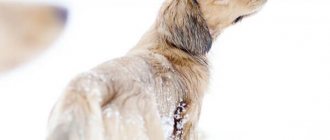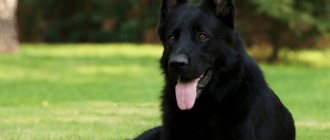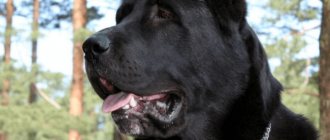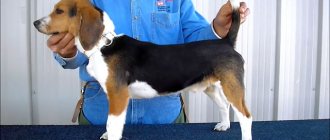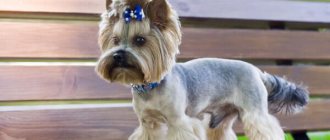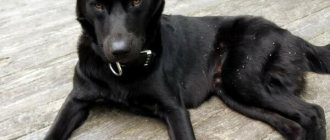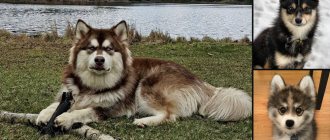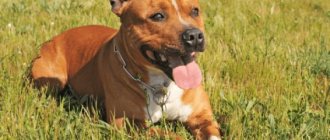Many families are looking to buy a German Shepherd.
After all, this is not only a guard, but also a companion.
She is good with children and trainable.
Incredibly smart and loyal.
This breed is also successful in service, because it easily manages to get used to new owners and a change of environment.
Thanks to this quality, it is almost indispensable in guard duty.
What is the breed standard
The German Shepherd Standard is a criterion established by the World Association of German Shepherd Owners and the Fédération Cynologique Internationale.
This is an officially recognized document for the examination of dogs of this breed in all countries of the world..
All standards are described for specialists. They contain a summary of the ideal characteristics of the breed, indicating possible faults and birth defects.
To correctly select a puppy and raise it, you need knowledge of individual articles, the causes of deficiencies and their impact on the general condition of the dog.
Expert opinion
Kozhevin Semyon Kirillovich
Expert dog handler.
“If you just walk in from the street and look at a puppy, you will hardly be able to distinguish a real German Shepherd from a similar mongrel. To see the differences and shortcomings at first glance, you need many years of experience, many years of studying the standard. Without it, it will be easy to fool you and sell you off to who knows who instead of a purebred puppy. So here you can only compare the points of the standard with the parameters and appearance of the dog that is offered to you.”
Historical data
In order to trace the pedigree of various types of breeds, even if they became known already in the 19th century, and even more so in the 20th century, it is enough to rummage through special documents or use eyewitness information. As for the German Shepherd breed, not everything is so simple, since experts say that the ancestors of this breed should be sought much deeper.
Archaeological data obtained as a result of excavations in the territories of some European countries indicate that back in the 4th millennium BC there were dogs whose skeletons were very similar to the skeletons of modern shepherd dogs. According to experts, their ancestors are wild individuals who lived near the sites of ancient people, as a result of which they began to obey the will of man.
Scientists also suggest that already in those days primitive breeding work was carried out, as a result of which preference was given to strong and obedient individuals.
The small Indian wolf, which no longer exists in our time, increasingly moved away from its independent relatives, eventually acquiring the status of Bronze Age dogs. As time passed, humanity gradually developed, as a result of which the needs of all humanity changed. Despite this fact, farmers and pastoralists have always been tied to a specific area. As a result, four-legged companions began to master new functions. Throughout Europe, and especially in the Middle Ages, it was customary to breed Hofwarts. Translated from German, this means “guardian of the yard,” although dogs also performed other functions not related to real estate protection.
In those days, the area was simply teeming with predators, and domesticated livestock needed protection. In addition, already in those days there were many who wanted to profit from other people’s goods. Man could not cope with his responsibilities on his own, especially when he had to graze numerous herds. Therefore, man had to take advantage of the capabilities of yard dogs. Not all dog breeds could cope with the protection of numerous flocks, but only those that were distinguished by endurance and intelligence. The problem was also to select and train the animal. Such dogs were so valuable that in those days, for killing a dog that was herding flocks of livestock, the culprit faced death punishment.
According to experts, animals of the Medieval period, including those of later eras, were significantly different from modern representatives of various breeds. In those days, the main attention was paid not to the shape of the body, but to the mental abilities of the animal and its endurance. No less important was the “psychological portrait” of the dog, which was always next to the person. As a rule, the shepherds were isolated for a long time, throughout the entire season of keeping the animals, so the dogs were in contact exclusively with the shepherds all this time. And here the most important thing is that the dogs unquestioningly perform their functions. Moreover, the dogs were supposed to become real friends and companions for the shepherds.
By the end of the 17th century, the main characteristics of herding dog breeds began to appear. Two regional breeds have become widespread: the semi-long-haired Thuringian dogs with a curled tail and a fawn-gray color, as well as the long-haired Württemberg dogs with semi-erect ears, distinguished by a black or red color. These 2 breeds also differed in their behavior. If the former were considered very active animals and often barked loudly, then the latter were calmer and more resilient. Therefore, the breeders decided to join forces to develop a completely new breed of dog.
A lot of time passed and at the end of the 19th century the result of long and painstaking work was presented to the general public. In 1882, Baron von Knigge presented two of his pets at the Hanover Exhibition. Interest in the new breed arose with renewed vigor when the owners of the Hannau kennel showed off their impressive pair. Thanks to this couple, at least 2 dozen champions and winners of subsequent dog shows were born.
In 1891, it became known about the creation of the first club of German Shepherd lovers, although this organization, called “Philax,” did not exist for so long, and it was able to determine the breed standards in such a short period. On the German-French border, in the city of Karlsruhe, an exhibition took place, which is considered to be significant. The event was not anything extraordinary, but at the exhibition many saw a unique representative of the old-format breed. However, he did not take part in the exhibition.
Hector von Lyrkenheit did not do anything supernatural, but only entertained the audience, demonstrating the shepherding skills of his pet. At that very moment, two friends happened to be nearby, who in their free time practiced breeding German Shepherds. They immediately noted that the dog’s external characteristics were not inferior to his shepherding skills. The owner refused for a long time to provide his dog for breeding work.
Since friends believed that they had got the ideal representative of this breed, they included him in the list of breeding work at number one. From that moment on, they began to look for a bitch for the dog who would have similar characteristics to him. It took very little time, and the couple produced offspring worthy of imitation of this breed. As a rule, even modern successors of this family have a purebred line associated with this “ideal German”.
Claude von Boxberg is considered another famous representative of this breed, since he took part in the 1925 international exhibition and won a landslide victory. This moment is considered the factor that marked the beginning of a new breeding line.
In 1936, when Max von Stephanitz died, members of the National Socialist Party insisted that the breed should not appear outside Germany. It is believed that the events of this period were the cause of his death, as national patriots threatened this man, intending to send him to a concentration camp. During the Second World War, many animals were destroyed, including nurseries for their breeding. Nobody cared about the purebredness of the surviving individuals. In fact, it was possible to preserve several purebred individuals, and in the post-war years there were enthusiasts who set to work to restore this unique breed. Already in 1946, exhibitions continued, and after another 5 years a new winner appeared, who became the founder of the modern lines of purebred German Shepherd.
The German Shepherd Owners' Union was created back in April 1899. The activities of the leaders of this Union were aimed at maintaining the purity of blood, confirming this with relevant documents. At the same time, it was practiced to encourage breeders who developed the working characteristics of the breed. This organization has survived to this day. In May 1968, an international association began its work, which is known today as , which has brought under its “wing” 89 national unions from 82 countries of the world.
GERMAN SHEPHERD – INTERESTING FACTS
What it looks like according to RKF and FCI
- Size . The height at the withers for males is 60-65 cm, for females 55-60 cm. The body is 10-17% larger than the height of the dog.
- Weight. Males weigh 30-30 kg, and females - 22-32 kg.
- Head . German Shepherds have a wedge-shaped head, which is 40% of the height at the withers. Its general impression is dry and moderately wide. The head should be proportional to the body. The forehead is convex, but without a groove. The ratio of skull to muzzle is 50% to 50%, the width of the skull is the same as its length. It tapers from the ears to the nose when viewed from above and becomes wedge-shaped. The jaws are powerful and well developed. The lips are dark, dry, and fit tightly.
- Wool . German Shepherds should have a coat with an undercoat. Its cover should be dense and tough. The hair on the head, inside the ears and on the front of the legs, paws and toes is shorter than on the rest of the body. On the back side of the limbs the hair is elongated and can form fringes.
- Paws . The front legs, when viewed from the front, are parallel to each other. The elbows are also straight; they are not allowed to turn in or out. The feet are round, well built and collected. The pads are quite hard, the claws are strong and dark in color. The hind limbs are slightly left, but also parallel to each other. The thighs have good and strong muscles. The hind legs are the same as the front legs.
- Nose . The nose is straight, without humps. The nose should be black.
- Ears . The German Shepherd has medium-sized ears, set vertically, pointing upward, not hanging out to the sides. They have sharp ends and are positioned with the shell facing forward. Broken ears or soft ears are not allowed. The ears may lie back when moving or at rest. This is not considered a defect.
- Eyes . The dog has medium-sized eyes, they are almond-shaped, not protruding, but slightly oblique. The standard allows only dark eyes; dogs with light ones are disqualified, they violate the conformation of the breed.
- Neck . The neck is strong, with well-developed muscles; there should be no dewlap on the throat. The angle to the body should be approximately 45 degrees.
- Frame . The topline runs continuously from the base of the neck to the pronounced withers and falls in relation to the horizontal of the back to the sloping croup. The back of the German Shepherd is well developed - strong and strong.
- Croup _ The croup is sloping. It should be long and slightly falling. It smoothly transitions to the base of the tail.
- Tail . The tail is the size of the hock joint. On its underside the fur is longer. It is held in a gently hanging curve, but under tension it can rise, but not above the horizontal. Docked tails are not allowed.
The process of education and training
German Shepherds are quite intelligent animals that are easy to train. But under no circumstances should this process be allowed to take its course. From the first months of its existence, the puppy is provided with all forms of various games and tasks. As a result of completing tasks and commands, the puppy must be rewarded with treats. As a result, the puppy develops certain concepts about the norms of acceptable behavior and the implementation of basic commands.
A person must demonstrate his mental abilities and love for an animal without raising his voice and, especially, without using physical force. Not everyone is able to cope with this difficult task on their own. Therefore, in the case when a person is not able to cope with this task, one should seek help from specialist dog handlers.
Naturally, not every individual is capable of performing security functions. Despite such facts, any shepherd dog must understand and follow basic commands, such as, “Come to me!”, “Place!”, “No!”, “Near!”, “Sit!”, “Lie down!”, “ Walk!”, “Fetch!”.
When the puppy gets stronger, you can begin physical activity, training the animal to overcome obstacles. It is especially important to train your dog to walk on a leash, and then, after reaching six months, in a muzzle. At the same time, we should not forget that the animal must be rewarded for obedience.
You should also remember that you need to do it in the first 3 years. During this period, the still young dog, which meets all the indicators of the breed standard, remains psychologically vulnerable, requiring care and love, as a puppy.
How does it move?
The German Shepherd is a trotting shepherd. The limbs are coordinated with each other in such a way that when moving, the animal can, without significant changes in the topline, move the hind limbs to the length of the body, just like the front ones.
The dog pushes off strongly with its hind legs, and at this time the front legs are carried beyond the border of the body to the same distance . The German Shepherd, which has a correctly built body, is slightly tilted forward when moving.
She moves easily and sweepingly. At the trot, when the head is bowed and the tail is raised, a continuous line of the back is visible from the tips of the ears to the tail.
Flaws
The breed disadvantages of the German Shepherd include the following:
- the absence of a third premolar and one more tooth;
- the absence of one canine;
- absence of the fourth premolar;
- absence of the first or second molar;
- the absence of three or more teeth;
- a bite of two millimeters or more;
- underbite;
- pincer bite;
- deviation of one centimeter in height prescribed by established standards;
- albinism;
- white hair color with dark claws and eyes;
- long guard hair, soft and loosely fitting, forming dewlaps in the ear area and feathering on the limbs with thick trousers and a tail with dewlap below;
- long coat without undercoat with partings along the back.
Serious faults include any deviations from existing standards that negatively affect the basic working qualities of an adult dog. The main ear defects of the German Shepherd are represented by ears located on the sides or too low, semi-dropping ears hung on the sides, as well as erect ears without elasticity. Significant defects also include impaired pigmentation, a noticeable decrease in the animal’s overall endurance, and disturbances in the dental apparatus, including any deviations from a scissor bite.
Return to content
Character traits
The German Shepherd has a balanced character. She has a stable nervous system, she is self-confident, sincere and friendly, if she is not in an excited state.
With all these qualities, she must be obedient, obey commands, easily remember them and train them.
Integral character traits of the animal are also loyalty, devotion, firmness, courage, well-developed fighting and service qualities. At the same time, the dog is an excellent companion, guard, protector and guard dog.
The German Shepherd treats children favorably and will never offend a child . She is distinguished by her instinct regarding the character of people, and is wary of ill-wishers.
Brief history of origin
The birthplace of the German Shepherd is Germany. Initially, representatives of the breed were used as a herding and service-search breed. However, these animals are now widespread throughout the world and perform many other functions.
The history of the German Shepherd breed dates back to 1899, when it was first presented at an exhibition. But the exact origin of the German Shepherd is unknown. According to the official version, it was bred on the basis of central and southern German herding dogs. Some experts believe that the blood of a wolf flows in her veins.
Color variations
The color of the German Shepherd is varied.
The coat can be black, gray, black and tan. Gray spots are allowed, but in small quantities. Combination with black is allowed, black mask on the face . In any case, the nose should remain black. A dog with white spots and white eyes may be rejected.
Also, the standard does not include completely white and red dogs.
White German Shepherds, like those with spots, are a defect - this indicates insufficient pigmentation in the body.
general description
Refined appearance, discipline, energy, neatness are exemplary traits of the breed. A breeding dog with an excellent sense of smell and absolute hearing, a stable central nervous system. Athletic and large build, slightly stretched, above average size.
The ratio of height and length is 9:10, respectively, height is less than length by about 10%.
Average height recorded by the standard:
- For males – 63 cm;
- For females – 56 cm.
A deviation of 2 centimeters is possible. Changes in different directions from the average height significantly reduce the pet's advantages.
The constitution of the body guarantees the feasibility of long running, and the coat protects from natural weather influences.
Sexual characteristics of cables and bitches are extremely pronounced. Clearly expressed, developed two testes near the cables are located in the scrotum.
Now let's look at the exterior of the German Shepherd, those predominant characteristics, the preservation of which is necessary when breeding pedigree breeds.
Read more in the article “Weight and height of the German Shepherd by month.”
Health and illness
Due to the correct body proportions, the German Shepherd is one of the breeds that is characterized by excellent and good health.
Their life expectancy ranges from 10 to 14 years .
However, there are diseases to which this breed is susceptible.
Therefore, it is important to recognize them in time and treat them:
- Hip dysplasia. This is an abnormal development of the hip joint that occurs as the dog matures and grows bones and joints. May cause hind leg failure;
- Epilepsy. This disease has no cure, but can be successfully suppressed with medications;
- Canine degenerative myelopathy. This disease is similar to human multiple sclerosis. Incurable;
- Anal furunculosis. The disease can be cured, but it tends to recur;
- Hemophilia. This is a blood clotting disorder. Only males are affected, but females are carriers;
- Pancreatic insufficiency. This is the most common disease in German Shepherds. They are doomed to take medication for the rest of their lives;
- Bloating and gastric volvulus. This disease is very dangerous. It occurs when a dog eats food quickly and then engages in physical activity. If you notice bloating in your dog, consult a doctor immediately, otherwise he may die in less than an hour.
Behavior, temperament
Despite changing breed standards, modern German Shepherds have perfectly preserved the best potential of their ancestors. The complex of mental qualities clearly defined in the breed includes mental alertness and firmness, combativeness and obedience, devotion to the owner and sensitivity, complemented by balance. The speed of reaction determines the liveliness of the dog’s temperament and is formed by the genotype.
Other characteristic breed qualities can largely be created by man, including such an important factor as the obedience of the German Shepherd against the backdrop of its innate desire to listen to the leader. Shepherd dogs need to feel a sense of community with people, and the development of this feeling is the direct task of the breeder using imprinting . All dogs that have not undergone imprinting are unsociable and extremely difficult to train.
This is interesting! The German Shepherd is one of the most versatile breeds in the world. Such a dog is ideal in almost any capacity, including a guide for blind people, a nanny and companion, as well as an unsurpassed security guard or bodyguard.
German Shepherd puppies are inquisitive by nature, but the owner of a pet of this breed can develop this feeling in the dog during the process of education and socialization. Fighting and aggressiveness are qualities necessary for a service breed, but such important and genetically determined characteristics are difficult to correct, which must be taken into account when choosing a puppy.
Return to content
Nutritional Features
When feeding your German Shepherd, you need to consider the ratio of proteins, fats and carbohydrates. Most of all should be meat, then come vegetables and grains, and only then vegetable or animal fats.
CAREFULLY!
German Shepherds should not be fed pasta, long bones, baked goods, flour, legumes, spices and canned foods.
You need to feed your dog twice a day at the same time. The food should not be too cold or hot, it should not contain excess liquid, and the meal itself should not last more than 20 minutes.
The best meats are turkey, beef, sometimes add lean pork . Beef bones and not tubular bones are also suitable, but they should be given when the dog is already full.
Buckwheat, oatmeal or rice are suitable cereals. It is allowed to give the dog raw or poached eggs several times a week.
Offal products are also suitable for feeding puppies . Calcined cottage cheese is also important for them.
Care and maintenance
The structure of the German Shepherd's coat is such that it can live both in a person's home and in the yard. If kept in the yard, it is necessary to build a spacious enclosure with a warm booth. It is advisable that the enclosure be protected from wind and precipitation.
If it is assumed that the shepherd will live in the house, then it is necessary to allocate its own place where bedding and a mattress, as well as various toys, should be placed. There should be no sources of heat or drafts near the animal’s place. When decorating a place, it is better to use natural materials that do not require complicated cleaning. The presence of various toys will allow you to save furniture and shoes from the encroachments of your toothy friend.
It is very important to provide your pet with proper, balanced nutrition, which will help protect the animal from abnormal development and the manifestation of illnesses. A complete diet is only possible if high-class (premium or super-premium) factory dry food is used. In this case, it is necessary to take into account the age categories of the animal. When eating natural foods, it is necessary to ensure a balance of fiber and protein intake. Under no circumstances should you give your shepherd dog leftover food from the human table, since the dog’s digestive system is not designed to consume fatty, fried, salty and other foods with seasonings. Fresh water should be freely available.
This breed does not require frequent washing of the dog with various shampoos, but as it gets dirty, it is necessary to do this. In this case, it is necessary to comb the coat a couple of times a week. When the animal sheds, this procedure will have to be carried out much more often. It is equally important to monitor the condition of the ears, eyes, teeth, and nose.
Experts recommend visiting a veterinarian at least 2 times a year.
German Shepherd - Care and Maintenance // Network of Veterinary Clinics Bio-Vet
Lifespan
The German Shepherd lives 10-14 years. In rare cases, her life lasts longer. The longest age recorded for this breed is 20 years. Males live 1.5-2 years less than females.
The better you care for your dog , the longer it will live, the better its health will be .
Musculoskeletal system
The spine is the basis of the body; the rest of the dog’s proportions depend on its ratio.
With an exact correspondence of length and symmetry to height, the bones form an excellent motor system. There is a feeling of movement, devoid of tension. When running serenely, the dog's limbs move in a diagonal progression, forming a continuous line from the end of the tail to the end of the ears.
The heights are combined as follows: the front legs move the same distance as the hind legs, approximately to the middle of the body. Any shift in the hind paw reduces stability and strength.
Standards for a puppy
The standard of a puppy is primarily related to his mental and physical health, and not to your liking :
- The dog should look healthy and happy with life.
- Even at a young age, a puppy already has a scissor bite;
- At 3-4 months, puppies’ ears are not yet erect. If you see erect ends, this means that there is a lack of vitamins, phosphorus and calcium in the body;
- The color is already typical for the breed and similar to the parent;
- The puppy should be strongly built: compact bones, straight back, straight tail, slightly curved, but not curled over the back, round paws, not too short, but not too long muzzle;
- When running, the puppy should push off with its hind legs and throw out its front legs;
- The dog's temperament is adequate and resistant to change. The dog should be curious, but not aggressive.
- Puppy disadvantages include: light eyes and claws, feathering on the head and ears, malocclusion, crooked limbs, white and light color, aggression, cowardice and imbalance, wavy hair.
Color
According to breed standards, the German Shepherd can be black in color with reddish-brown, brownish, yellow or light gray markings. The color can be monochromatic black and gray, but with a gray color with a darker coating. The undercoat is characterized by a light grayish tone, but white color is unacceptable. The color may have a black cloak and mask. The presence of inconspicuous small white markings in the chest area, as well as too light inner sides, is quite acceptable, but not desirable.
The nose of animals of any color should be exclusively black. Weakness of pigment may be represented by the absence of a mask, piercingly light eyes, and light to white markings on the chest or inner sides. Also, the weakness of the pigment is indicated by light claws and the presence of a red tip on the tail.
Return to content
How much does a purebred breed cost?
Depending on the class of the puppy, the price changes. But if we combine all three standards - pet class, breed class and show class, then the price range for a German shepherd varies from 10 thousand rubles to 650,000 thousand rubles.
NOTE!
The price depends on the region of purchase, the health of the dog, the availability of vaccinations and documents, pedigree, age, color, class, the place where you buy the puppy (kennel, breeder, private person), as well as on the title/non-title status of the parents.
Pros and cons of the breed
| Advantages | Flaws |
| High intelligence | Heavy shedding |
| Good learning ability | The need for constant physical and mental activity |
| Excellent watchdog and security qualities | Difficult to keep in an apartment |
| Child Compatible | Possible problems with the musculoskeletal system |
| No unreasonable aggression | – |
| Endurance | – |
| Beautiful appearance | – |
| Versatility | – |
The German Shepherd is a wonderful companion, guard and protector. But for a pet to become a true friend, it needs to be given a lot of attention, raised and trained correctly.
How to choose a dog?
To choose the right German Shepherd puppy, refer to the standard.
If the puppy looks as it should for its breed, and this was mentioned earlier, then look at its health and behavior:
- The mucous membranes should be pink and clean. There should be no discharge from the eyes and ears;
- A healthy puppy smells pleasant and there is no bad breath;
- The coat is soft, beautiful, without fleas and ticks. The skin under the fur should be free of wounds and scratches;
- Pay attention to how the puppy eats, wait until he goes to the toilet and look at the stool - the dog should not have worms;
- A healthy dog with a normal psyche is friendly, active, playful, and inquisitive. At the same time, he tries to please the person by listening to him;
- Play with the puppy and talk. His gaze should be meaningful and intelligent.
A bloated stomach can also indicate the presence of parasites in the body.
Caring for German Shepherd puppies
To raise a healthy animal, you need to properly care for it and provide it with a balanced diet. Small dogs are actively growing, so they are fed more often than adults:
- up to 2 months – 6 times a day, 200 ml portion;
- 2–3 months – 5 times, 300 ml portion;
- 3–6 months – 4 times, 500 ml portion;
- 6–10 months – 3 times, serving 0.75–1 l.
From 10 months, puppies are transferred to two feedings a day.
Important. If you know the normal weight of a German Shepherd puppy by month, you can quickly notice developmental delays or other pathologies that threaten the baby’s well-being.
Peak weight gain occurs in the first 4 months of life. Exhaustion, like extra pounds, is fraught with diseases of internal organs, bones and tendons, and deterioration of the condition of teeth, skin and fur. The development of a German Shepherd puppy can be traced according to the norms of age and physical parameters:
- newborn male puppies weigh about 500 g, female - 350 g. If the litter is small, the indicators increase by 100–150 g. The same rule works in the opposite direction - in large litters the weight will be slightly less;
- German Shepherd puppies: 1 month – pets are developing intensively. Every day their weight increases by about 100 g;
- At 2 months old, German Shepherd puppies are still very clumsy. A puppy at 2 months should weigh 4–5 kg. At this time, it is better to keep him on natural feeding. Along with milk, dogs receive antibodies that are important for the formation of immunity. By the end of the 2nd month, the German Shepherd puppy should weigh about 8 kg;
- at 3 months, the German Shepherd’s weight reaches 14 kg, height – up to 48 cm. At 3 months, the German Shepherd actively explores the world around him - it’s time to start socialization and training;
- at 4 months the dog becomes more massive: the skeleton becomes heavier, the chest increases in volume. For full development, she must eat a dense and balanced diet. A German Shepherd puppy at 4 months reaches 55 cm in height and weighs up to 20 kg;
- 5 months – during this time, attention is paid to the dog’s intellectual development. The growth rate is slowing down a bit, but is still quite high. The weight of a German Shepherd at 5 months increases to 23 kg, height – up to 58 cm;
- 6 months – adolescence begins. The dog is already very similar to an adult animal: height up to 60 cm, weight about 26 cm;
- 7 months – the change of teeth is completed, the reproductive organs are formed. The pet gains muscle mass and grows more in width than in height;
- from 8 to 10 months, growth practically does not change, the weight of the German Shepherd reaches 33 kg. The bones are strengthened, the dog is ready to receive more physical activity without compromising its health.
By the age of 1 year, height growth finally stops. However, the pet is still gaining weight due to muscle growth. Growing up ends at 2, and sometimes at 2.5–3 years.
Wool
The rough hair on the head is shorter and softer to the touch than on the legs, toes, neck and back of the ears. On the hips it forms something like pants.
The coat of a real German comes in three types:
- normal coat;
- long-haired breeding dog;
- long-haired shepherd dog.
Disadvantages: Too thick, long coat is considered a fault. Especially on the tail.



